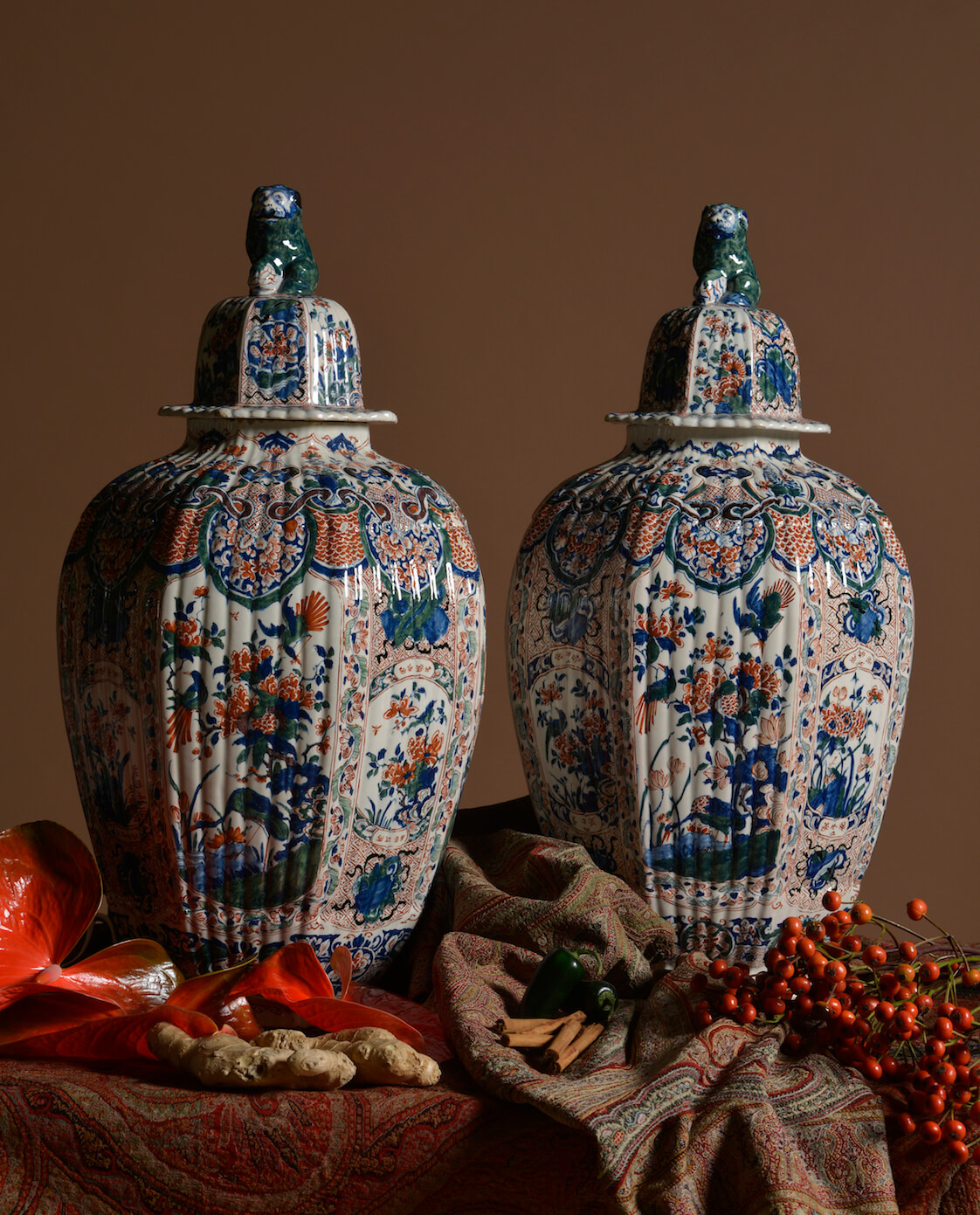
Cashmere Color Palette
Exotic scenes on Delftware
Warm, intense colors; rich, dense patterns; landscapes with lush plants and exotic animals, the pair of vases above exude an exotic feel. While they might not seem to be typically Dutch, you might be surprised because the vases were made in Delft around 1700, using the cashmere color palette. Characteristic of this type of earthenware is the full decoration in blue, red and green on the often fluted surfaces.
 There is a common misconception that Delftware only comes in blue and white because of the global fame of Delft Blue. The Delftware that was produced starting around 1650 did indeed have the characteristic blue and white decoration. The earliest examples of Delftware were inspired by the Chinese porcelain that arrived in the Dutch Republic via the VOC (the Dutch East India Company) in the 17th century. This popular porcelain was white with blue decoration. The use of blue was also a practical choice because it was the easiest color to fire on ceramics. Cobalt, which provides the blue color, is resistant to high temperatures. Since there was little room for error during the firing process, the color blue was a safe choice for many factories.
There is a common misconception that Delftware only comes in blue and white because of the global fame of Delft Blue. The Delftware that was produced starting around 1650 did indeed have the characteristic blue and white decoration. The earliest examples of Delftware were inspired by the Chinese porcelain that arrived in the Dutch Republic via the VOC (the Dutch East India Company) in the 17th century. This popular porcelain was white with blue decoration. The use of blue was also a practical choice because it was the easiest color to fire on ceramics. Cobalt, which provides the blue color, is resistant to high temperatures. Since there was little room for error during the firing process, the color blue was a safe choice for many factories.
China
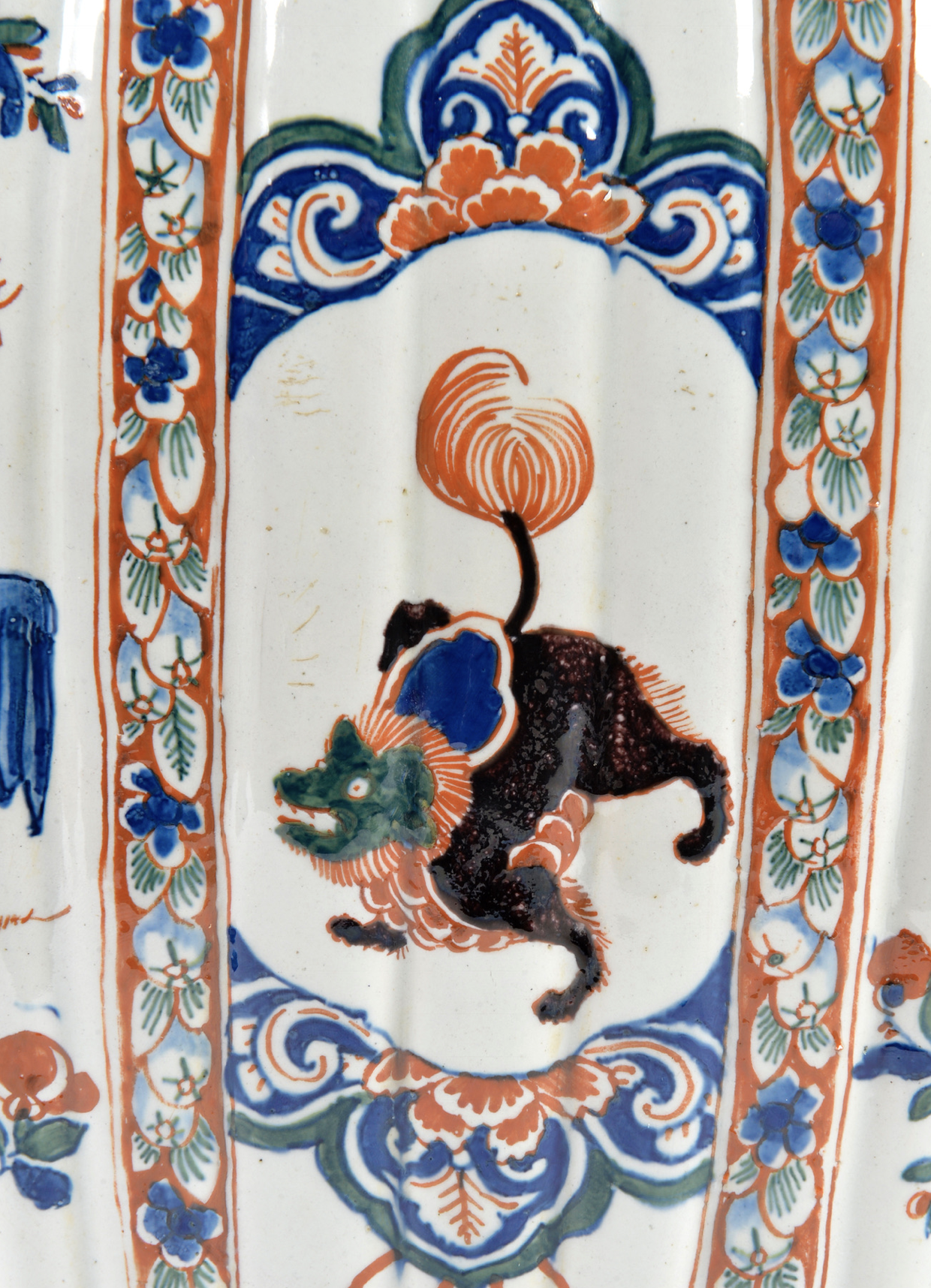 However, it was not only blue porcelain that reached the Republic. Little by little, multicolored Chinese porcelain quickly made its appearance and, naturally, the Delft factories did not want to miss out. Inspired by the Chinese Famille Verte porcelain from the Kangxi period (1662-1722) that arrived in Europe at the end of the 17th century, they started experimenting with colors. The grand feu technique, in which the objects were fired at a high temperature of approximately 1000°C (±1800ºF), was refined. This resulted in new colors, and the classic blue decoration was supplemented with red and green. Yellow was sometimes used for extra emphasis on pieces, but black was an even rarer addition. Black was reserved for special pieces because it was a difficult color to apply to earthenware. Painters often used dark manganese instead of black, as can be seen in the pair of covered vases, where the mythical animal, called the ‘qilin’, is depicted in manganese. In addition to the colors, the subjects on the Delft cashmere objects were also derived from Chinese porcelain. Rocky landscapes, exotic birds flying in the sky or perched on branches of chrysanthemums, fluttering insects, and mythical animals all adorn the Delft objects. These motifs were sometimes combined with pseudo-Chinese characters, as can be seen on the pair of vases with covers bearing the mark of Lambertus van Eenhoorn, owner of the De Metaale Pot factory. To the best of our knowledge, these pseudo-Chinese characters were freely interpreted and their original meaning has been lost. Delftware painters often appropriated the Chinese visual language, which naturally captured the imagination of the European clientele looking for objects with an exotic Asian flair.
However, it was not only blue porcelain that reached the Republic. Little by little, multicolored Chinese porcelain quickly made its appearance and, naturally, the Delft factories did not want to miss out. Inspired by the Chinese Famille Verte porcelain from the Kangxi period (1662-1722) that arrived in Europe at the end of the 17th century, they started experimenting with colors. The grand feu technique, in which the objects were fired at a high temperature of approximately 1000°C (±1800ºF), was refined. This resulted in new colors, and the classic blue decoration was supplemented with red and green. Yellow was sometimes used for extra emphasis on pieces, but black was an even rarer addition. Black was reserved for special pieces because it was a difficult color to apply to earthenware. Painters often used dark manganese instead of black, as can be seen in the pair of covered vases, where the mythical animal, called the ‘qilin’, is depicted in manganese. In addition to the colors, the subjects on the Delft cashmere objects were also derived from Chinese porcelain. Rocky landscapes, exotic birds flying in the sky or perched on branches of chrysanthemums, fluttering insects, and mythical animals all adorn the Delft objects. These motifs were sometimes combined with pseudo-Chinese characters, as can be seen on the pair of vases with covers bearing the mark of Lambertus van Eenhoorn, owner of the De Metaale Pot factory. To the best of our knowledge, these pseudo-Chinese characters were freely interpreted and their original meaning has been lost. Delftware painters often appropriated the Chinese visual language, which naturally captured the imagination of the European clientele looking for objects with an exotic Asian flair.
The French Court
Earthenware painters also looked closer to home for inspiration when decorating the cashmere pieces. The French Baroque style that reigned in Europe at the time of King Louis XIV was one such source of inspiration. The style of Versailles was reflected in the Dutch decorative arts and can mainly be seen in the cashmere pieces of Delftware. After the Revocation of the Edict of Nantes in 1685, many French architects and decorators fled the threat of the persecution of Protestants. Many of them settled in the Netherlands, including the well-known designer and engraver Daniel Marot. He became the official architect of Stadtholder William III, the Prince of Orange, who entrusted him with the furnishing of his home, Paleis Het Loo. In his palace designs, Marot followed the style of Jean Berain, one of Louis XIV’s official designers at the Manufacture des Gobelins. Jean Berain’s style is characterized by the delicate use of arabesques and whimsical grotesques that originated in the Renaissance.
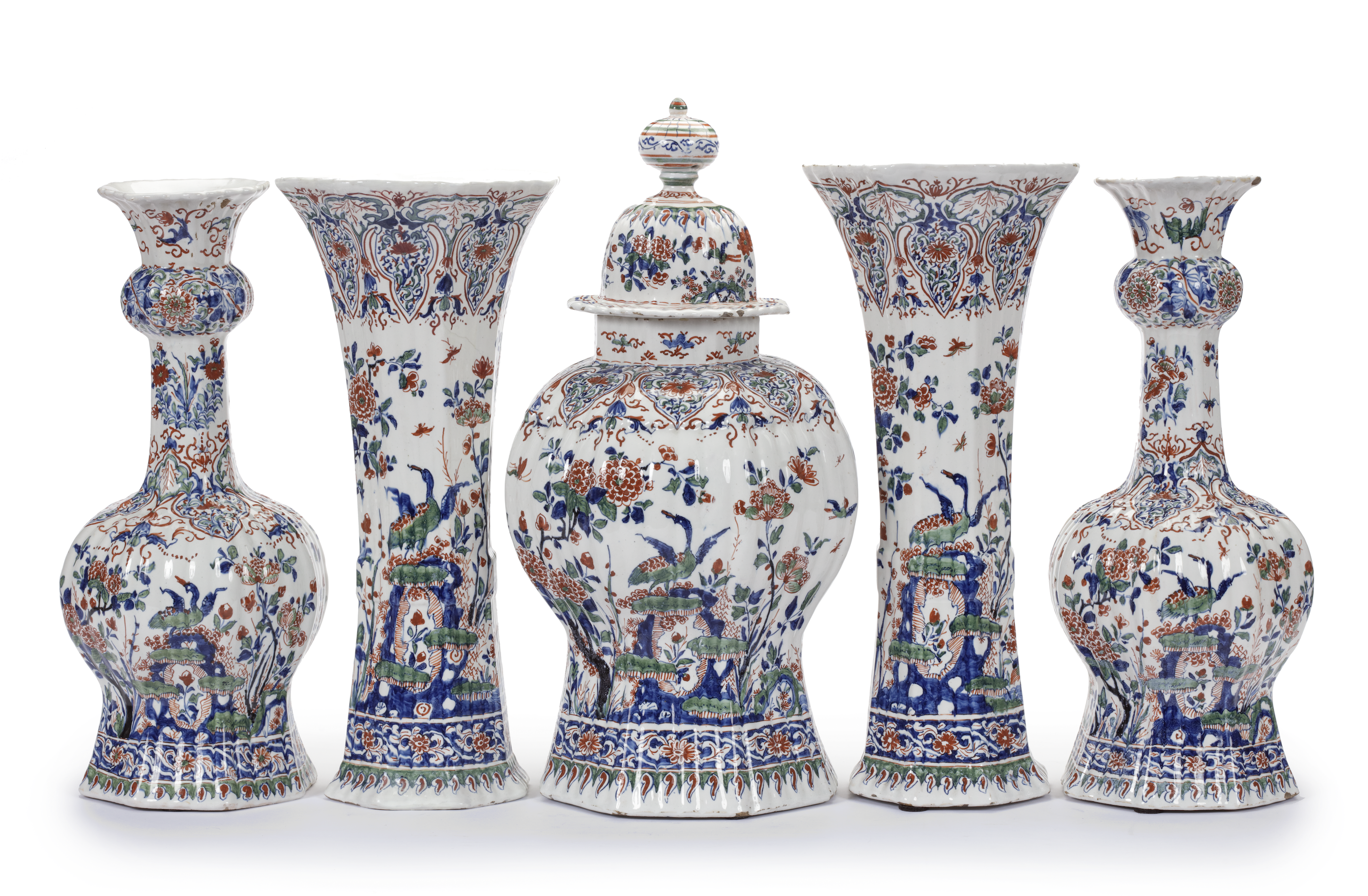 Using light floral motifs, Berain combined foliage with human and animal forms. The cashmere decoration on Delftware shows many similarities with Berain’s designs. The Asian scenes were set between lambrequins of lace and an abundance of flower garlands, draperies and curls. There are many objects with their white backgrounds almost completely covered in the decoration. The taste for lavish decoration undoubtedly encouraged the painters to use a bright, albeit limited, palette, which gave the Delft pieces a rich, sumptuous feel.
Using light floral motifs, Berain combined foliage with human and animal forms. The cashmere decoration on Delftware shows many similarities with Berain’s designs. The Asian scenes were set between lambrequins of lace and an abundance of flower garlands, draperies and curls. There are many objects with their white backgrounds almost completely covered in the decoration. The taste for lavish decoration undoubtedly encouraged the painters to use a bright, albeit limited, palette, which gave the Delft pieces a rich, sumptuous feel.
Factories
While the cashmere designs were borrowed from Chinese and French examples, the fluted shapes of the objects were derived from European silver. Delft factories required a great deal of knowledge and expertise to convert into earthenware shapes originally worked in metal. It was a very expensive and delicate process to create the fluted surfaces on the objects.
Due to the complex production requirements, the fluted objects with cashmere decoration were mainly manufactured in the large, most renowned factories, such as De Grieksche A and De Metaale Pot. At the beginning of the 18th century, under the ownership of Pieter Adriaensz. Kocx (1701-1703) and especially during that of his widow Johanna van der Heul from 1703 to 1721, experiments were carried out at the De Grieksche A factory using various styles and techniques. Several craftsmen were brought in to experiment with new colors and the application of gilding. In addition to the many platters, plates and vases that were created in the cashmere palette, objects with shapes that are more difficult to manufacture, such as flower vases and jardinières, were also created here. A lot of tableware and accessories, such as tea boxes and teapots, were also made here.
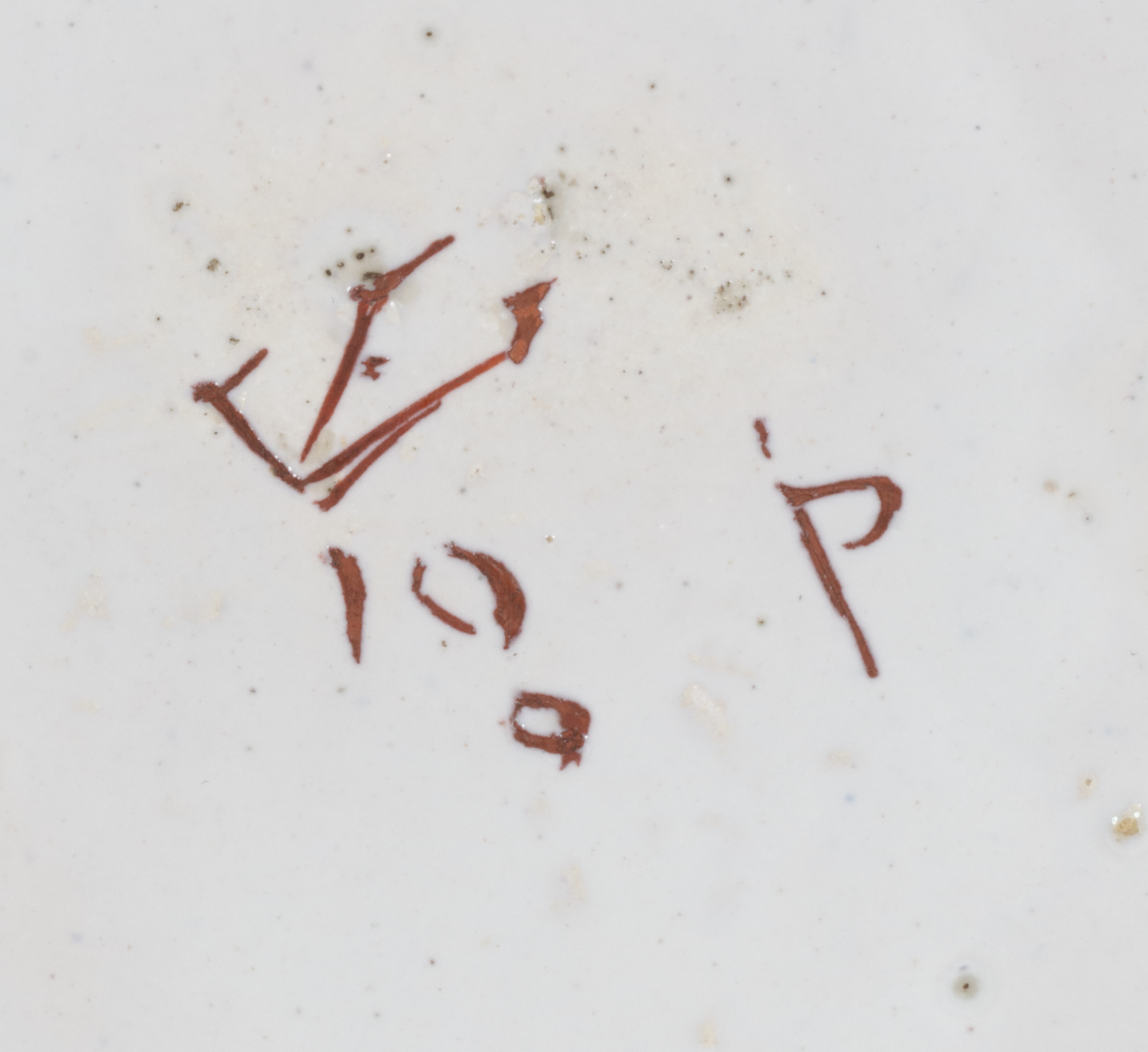 The most famous factory for Delft cashmere objects is probably De Metaale Pot during the ownership of Lambertus van Eenhoorn from 1691 to 1721. Under Van Eenhoorn, De Metaale Pot also undeniably played a pivotal role in the development of new colors and decorative schemes, which led to the development of the cashmere palette. While it cannot be said with certainty that Van Eenhoorn was the inventor, he was undoubtedly very influential the style’s production and its spread. Based on the marks that can often be found on the cashmere objects next to the manufacturer’s mark, it is likely that Van Eenhoorn employed an experienced craftsman who was responsible for the new colors. The monogram LVE is often accompanied by a size, a possible decoration code, or a monogram of the painter. That Van Eenhoorn surrounded himself with exceptionally talented craftsmen who produced the most exquisite objects is also apparent from the fact that he hired a sculptor. Unlike many other factories that were so focused on the decoration of the objects that they often overlooked the creation of new shapes, Van Eenhoorn saw the importance of this. As far as we know, he was the only owner of a factory in Delft who hired a sculptor to design objects. In 1691, he contracted the Frenchman Guillaume Neuillet as a modeler. Neuillet’s work must have been exemplary, since his contract was extended for ten years in 1693. An archive document stated that Neuillet’s molds would become the property of Van Eenhoorn after his death. Drawing on his renowned craftsmen and employees, Van Eenhoorn left a lasting mark on the development of Delftware.
The most famous factory for Delft cashmere objects is probably De Metaale Pot during the ownership of Lambertus van Eenhoorn from 1691 to 1721. Under Van Eenhoorn, De Metaale Pot also undeniably played a pivotal role in the development of new colors and decorative schemes, which led to the development of the cashmere palette. While it cannot be said with certainty that Van Eenhoorn was the inventor, he was undoubtedly very influential the style’s production and its spread. Based on the marks that can often be found on the cashmere objects next to the manufacturer’s mark, it is likely that Van Eenhoorn employed an experienced craftsman who was responsible for the new colors. The monogram LVE is often accompanied by a size, a possible decoration code, or a monogram of the painter. That Van Eenhoorn surrounded himself with exceptionally talented craftsmen who produced the most exquisite objects is also apparent from the fact that he hired a sculptor. Unlike many other factories that were so focused on the decoration of the objects that they often overlooked the creation of new shapes, Van Eenhoorn saw the importance of this. As far as we know, he was the only owner of a factory in Delft who hired a sculptor to design objects. In 1691, he contracted the Frenchman Guillaume Neuillet as a modeler. Neuillet’s work must have been exemplary, since his contract was extended for ten years in 1693. An archive document stated that Neuillet’s molds would become the property of Van Eenhoorn after his death. Drawing on his renowned craftsmen and employees, Van Eenhoorn left a lasting mark on the development of Delftware.
Other factories, such as De Dubbelde Schenkkan, De Roos and De Witte Ster, also used the color palette and repertoire of cashmere decoration but mainly applied it to pieces that were formed on the pottery wheel, which is why these objects often have smooth surfaces. A few vases with the De Roos mark are exceptions to this.
Origin of the name cashmere
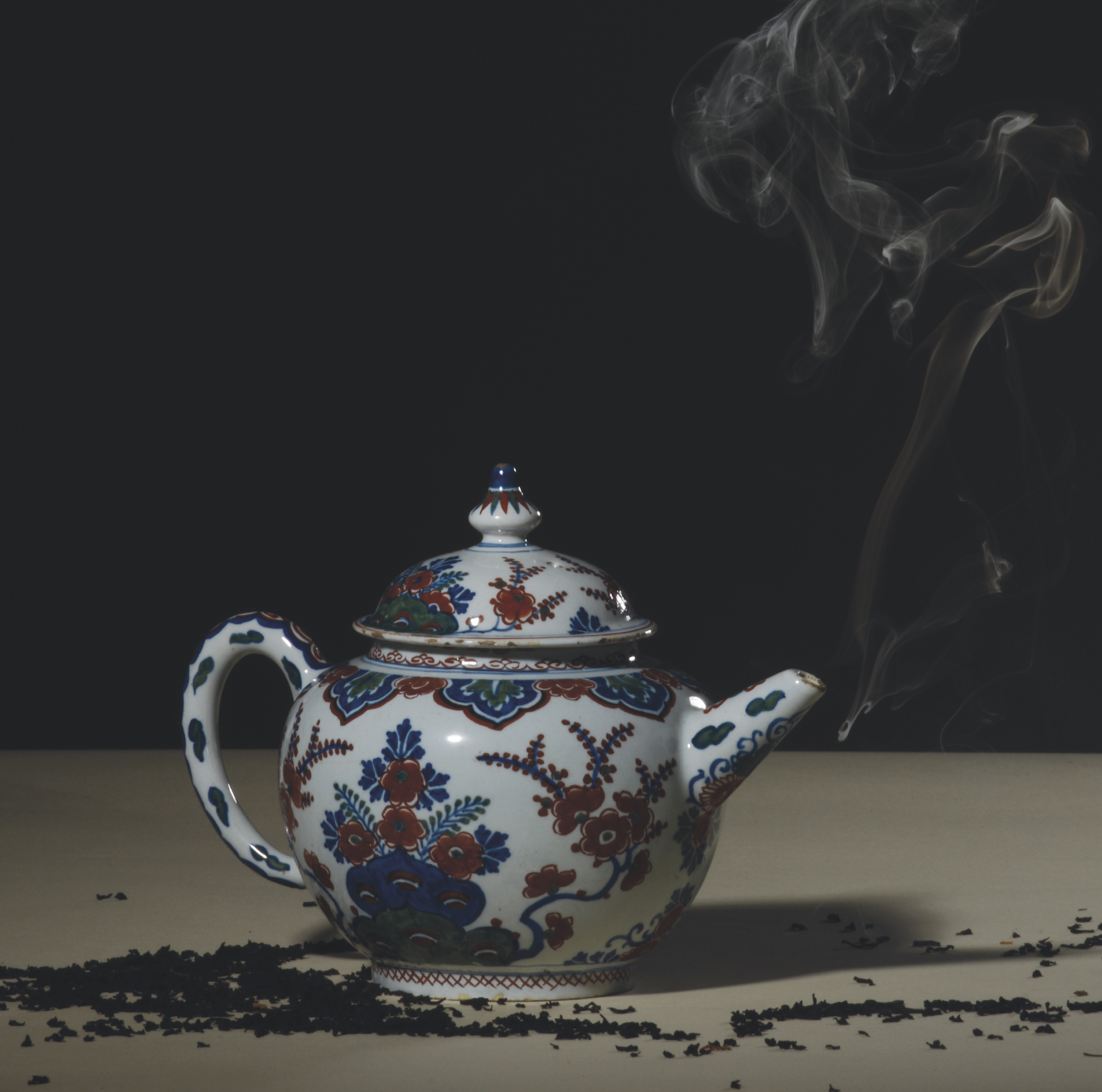 Inspired by Chinese porcelain, decorations at the French court and European silver models, the source of the name of this Delftware is not obvious. In the mid-19th century, there was a rediscovery of Delftware, and European collectors developed a great appreciation for Dutch earthenware. Previously largely ignored and regarded as expensive, out-of-fashion tableware, these Delft objects were suddenly much sought after by art collectors. In particular, the colored Delft objects made between 1700 and 1720, including the cashmere pieces, were among the most coveted objects. In addition to the collectors, intellectuals had developed a great deal of interest in Dutch earthenware. This was the first serious attempt to compile, classify, and study Delftware. The names given to the shapes and decorations were assigned by the early Delftware connoisseurs and reflect their contemporary world view, so they have little to do with the original background of the design itself. As Asia and its exotic wares were also a source of fascination for intellectuals in the mid-19th century, the Delftware in this style was given the descriptive title ‘cashmere’ because of the similarity in color to and the exotic, lush motifs on the fine wool scarves imported from India and worn by high-class European ladies.
Inspired by Chinese porcelain, decorations at the French court and European silver models, the source of the name of this Delftware is not obvious. In the mid-19th century, there was a rediscovery of Delftware, and European collectors developed a great appreciation for Dutch earthenware. Previously largely ignored and regarded as expensive, out-of-fashion tableware, these Delft objects were suddenly much sought after by art collectors. In particular, the colored Delft objects made between 1700 and 1720, including the cashmere pieces, were among the most coveted objects. In addition to the collectors, intellectuals had developed a great deal of interest in Dutch earthenware. This was the first serious attempt to compile, classify, and study Delftware. The names given to the shapes and decorations were assigned by the early Delftware connoisseurs and reflect their contemporary world view, so they have little to do with the original background of the design itself. As Asia and its exotic wares were also a source of fascination for intellectuals in the mid-19th century, the Delftware in this style was given the descriptive title ‘cashmere’ because of the similarity in color to and the exotic, lush motifs on the fine wool scarves imported from India and worn by high-class European ladies.
Period of popularity
The cashmere palette enjoyed brief but widespread success in the first half of the 18th century. The style had possibly gone out of fashion and the development of the petit feu colors offered the Delft manufacturers new experimental opportunities, but the main reason was probably because the production of these elaborate fluted pieces was too expensive. Nevertheless, the cashmere style remains one of the greatest achievements of the Delftware painters and perfectly embodies the splendor of exotic Asia.
Origin: This article was first published in Dutch in Vind Magazine #48, December 2022
Text by: Celine Ariaans, MA, gallery manager at Aronson Antiquairs.



